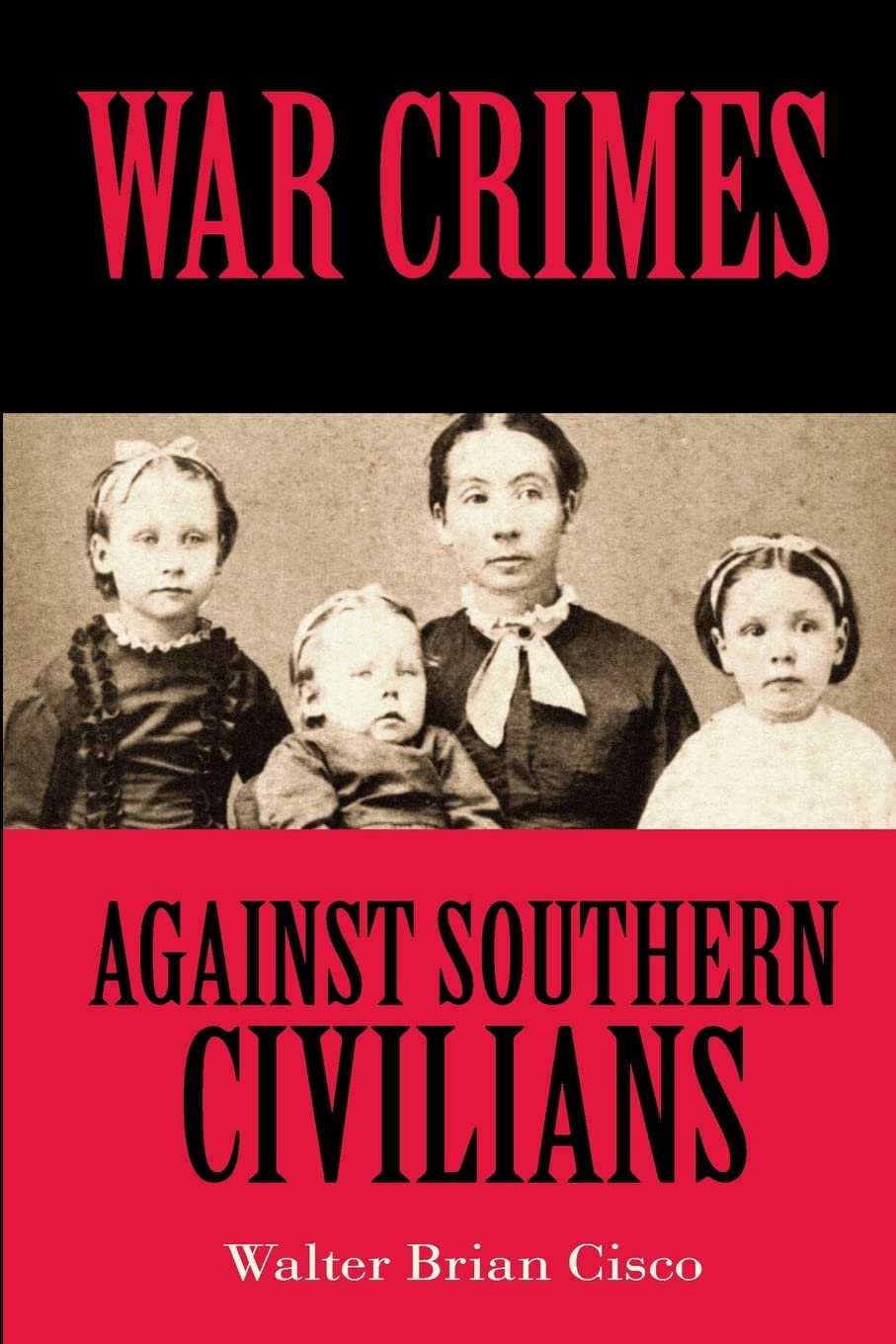We frequently read today about war crimes, such as bombing hospitals. In World War II Britain bombed civilians in Dresden and dropped atomic bombs on Hiroshima and Nagasaki. In war, we are told, “anything goes.” Abraham Lincoln followed this barbaric policy, and those who treat him as a “hero” have much to answer for.
In his definitive book War Crimes Against Southern Civilians (Pelican 2007), the historian Walter Brian Cisco blames Lincoln for a brutal campaign of Terror against the South:
A Review of War Crimes Against Southern Civilians by Walter Brian Cisco (Pelican, 2007).
Walter Brian Cisco is a lifelong scholar of American Civil War history, a professional writer, and researcher with many respected publications on the subject including States Rights Gist: A South Carolina General of the Civil War, Taking a Stand: Portraits from the Southern Secession Movement, Henry Timrod: A Biography, and Wade Hampton: Confederate Warrior, Conservative Statesman. In his latest book War Crimes Against Southern Civilians, Cisco writes on a subject that many historians have avoided, war crimes committed by the Union forces on the civilian population of the South beginning in the early years of the Civil War.
In his book, Cisco does a commendable job of uncovering historical records from the time period in citing from sources that include accounts from enlisted Union soldiers that were involved in the events, official reports, letters, diaries, and various other testimonials from civilians that tell of the monstrosities committed against Southern population throughout the Civil War. Early in his book, Cisco clearly states Lincoln had adopted the “black flag” policy and this policy was executed by several Union commanders in dates far preceding the better known Sherman’s March to the Sea. “Warring against noncombatants came to be the stated policy and deliberate practice in its subjugation of the Confederacy. Abraham Lincoln, the commander in chief with a reputation as a micromanager, well knew what was going on and approved” (pg. 16). Several pieces cited support this claim and are presented throughout the book.
The evidence offered supporting the “black flag” policy adopted by the Lincoln administration is done in numerous ways. A few examples presented are incidents such as the 1861 St. Louis massacre in which twenty-eight civilians lay dead in the streets of St. Louis and seventy-five others were wounded by the hands of a force of between six and seven thousand Union regulars and German volunteers commanded by Capt. Nathanial Lyon (pg. 22 and 23). The 1862 occupation of New Orleans in which Maj. General Benjamin Butler, establishes martial law whose “decrees were worthy of a czar” and in one infamous order, commanding Union soldiers to treat the ladies of the town as prostitutes which could be “construed as a license for rape” (pg. 65). Other accounts are crimes committed against non-combatants were the attacks on Southern pacifist religious refugees, in which Sheridan’s army robbed, plundered, poisoned wells with dead animal carcasses, and burned their houses to the ground during the Shenandoah Valley campaign of 1864 (pg. 124). Cisco cites several instances in which slaves and free blacks were robbed, raped, and killed by the hands of Union soldiers. Cisco’s book is filled with damning evidence of the war crimes committed by the Union forces on the South. Any reader of this book has to question how a soldier in the U.S. military could justify the inhumane actions that were taken against a civilian population which included the elderly, women, children and slaves. The accounts of Union aggression stated seems surreal and brings forth a question of fallacy that has been planted in the minds of generations of Americans far from what the Union cause truly was about.
War Crimes Against Southern Civilians chapters are organized by engagements recorded from 1861-1865 and follows the timeline very closely. The organization of the chapters is done in a manner that it is easy for a reader to follow and creates a clear account of how these events progressed throughout the war. The author also does a good job citing sources in the book and those that are used are accurate, but the format used in citing the information are not very user friendly. The pages within the text are void of footnotes and somewhat of a nuisance for readers who want quick access to citations presented on the page they are reading. Cisco does not include any footnotes in the book or endnotes at the end of each chapter, but instead lists all notes at the end of the book. Even though the book is well written, improvements could be made through the way notes are arranged and should do so if an updated version of the book is ever released.







I sent Mr. Rockwell a personal thanks for writing this piece. It is truly outstanding.
John M. Taylor
Of course, all the details are important. But the evidence is there even for the casual reader. In Volume One of his trilogy, Shelby Foote wrote regarding the Peninsula Campaign: “To McClellan in front of Richmond went a wire: ‘Can you get near enough to throw shells into the city?'” (Lincoln sent the wire.)
It was long before anyone had dreamed of precision-guided weapons.
History is rightfully turning on Dishonest Abe. His days of holy martyrdom are ending. I find that more people lately are questioning what they have been taught about old Abe, probably, and maybe ironically, in an attempt to understand the federal corruption and tyranny that is happening these days.
Unfortunately, alleged respites from the left’s diatribe such as Fox News, Hannity, Beck, Levin and Newsmax and other “conservative” outlets still beat the Lincoln drum ad nauseum.
All of these Lincolnites are fall in line southern bashers with occasional accurate stories chummed in the mix to keep us circling back, to swim around the bait.